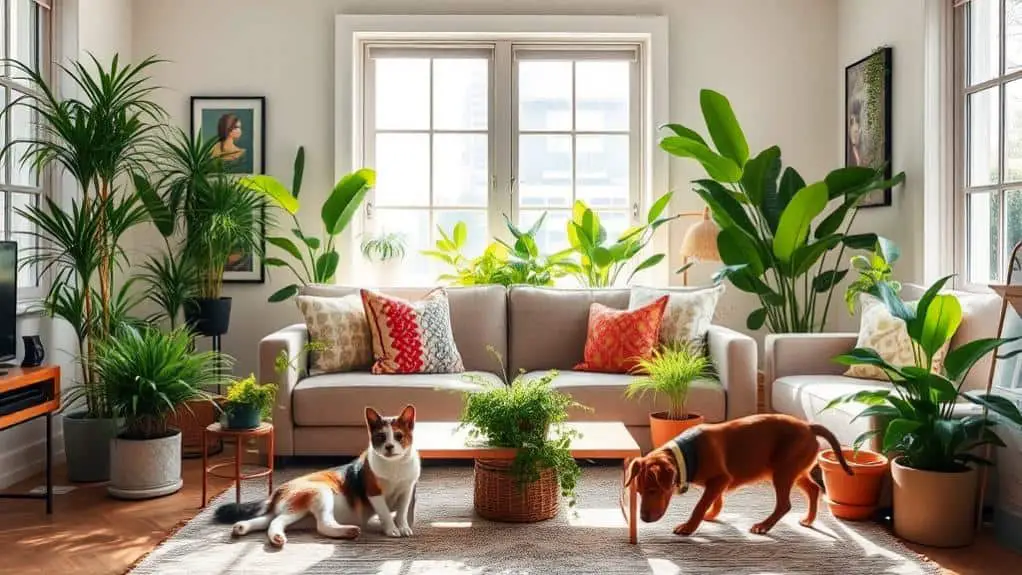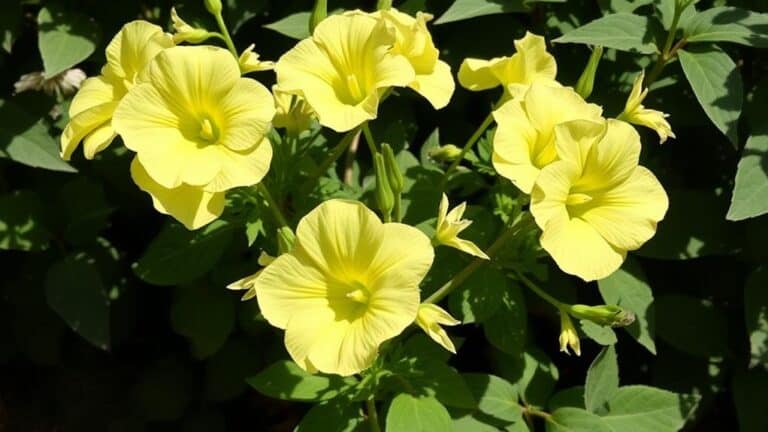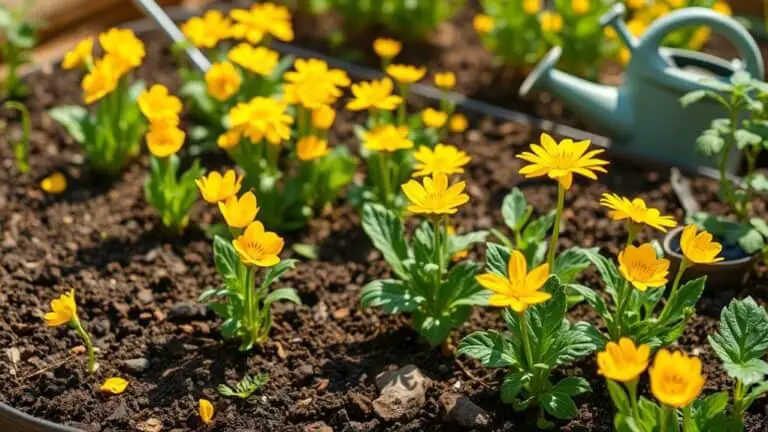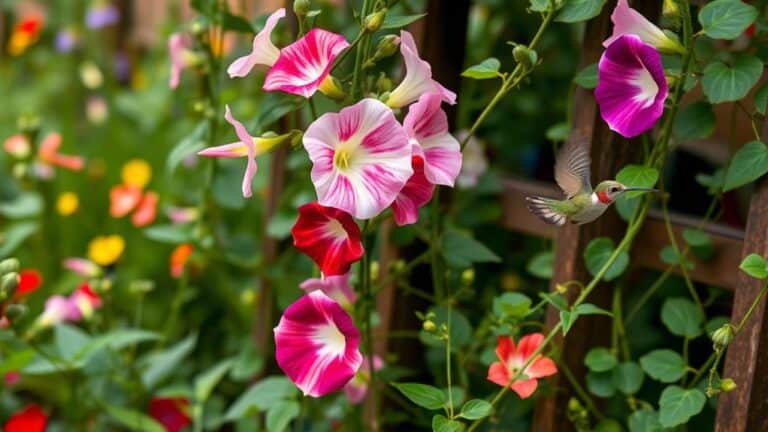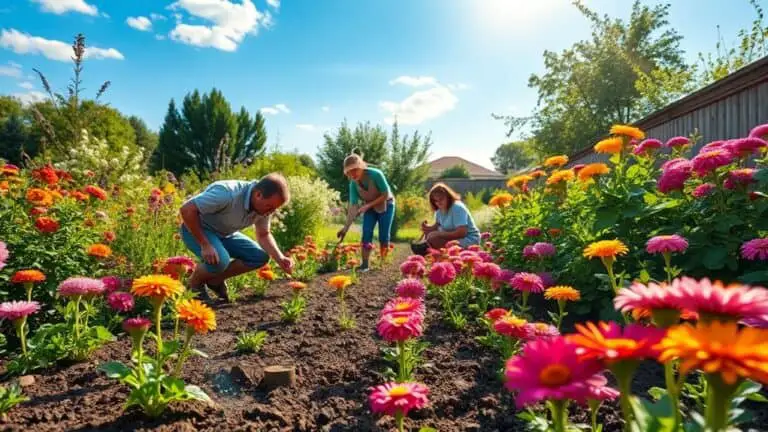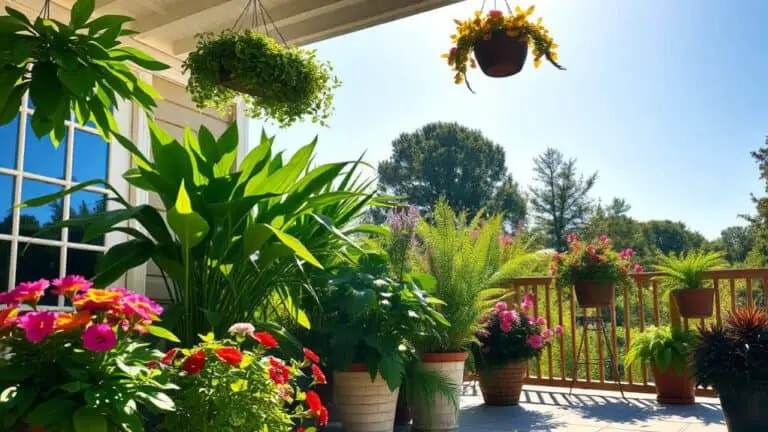Plants That Are Not Harmful To Your Pets
As a pet owner, I’ve always been cautious about the plants I bring into my home, making certain they’re safe for my furry companions. There are several beautiful options that won’t pose a risk, like the Chinese Money Plant and the Spider Plant. These varieties not only add a touch of nature to any room but also thrive with minimal maintenance. However, it’s important to know which specific plants are truly pet-friendly and why they are suitable for our homes. Let’s explore these options and guarantee our living spaces are both stylish and safe.
Chinese Money Plant
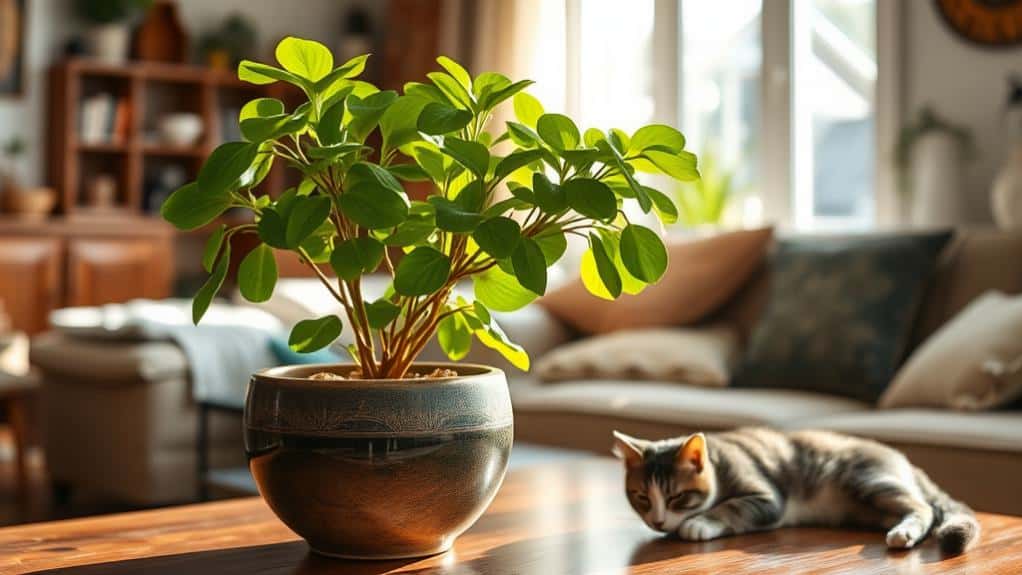
One of my favorite pet-safe plants is the Chinese Money Plant, also known as Pilea peperomioides. Its unique, round, coin-like leaves add a fun aesthetic to any indoor space.
The best part? It’s non-toxic to pets, so it’s safe for both cats and dogs. This plant thrives in medium to bright indirect light and needs watering every 1-2 weeks. Make sure the soil dries out between waterings.
I love how easy it’s to propagate; the plant produces “pups” or baby plants that you can share with friends. For the best shape and symmetry, remember to rotate it regularly.
If you’re looking for pet-safe plants, the Chinese Money Plant is a wonderful choice!
Money Tree
Another fantastic option for pet-safe indoor greenery is the Money Tree, also known as Pachira aquatica. This non-toxic plant is safe for both cats and dogs, making it a perfect choice if you have pets.
The Money Tree is quite hardy and thrives in medium to bright indirect light. One of the best parts is that it’s easy to care for—just water it every 1-2 weeks, allowing the soil to dry between waterings.
This plant can grow quickly, creating a lush indoor environment without any risk to your pets. Plus, it’s believed to bring good luck and fortune, often featuring beautifully braided trunks.
Hoya Varieties
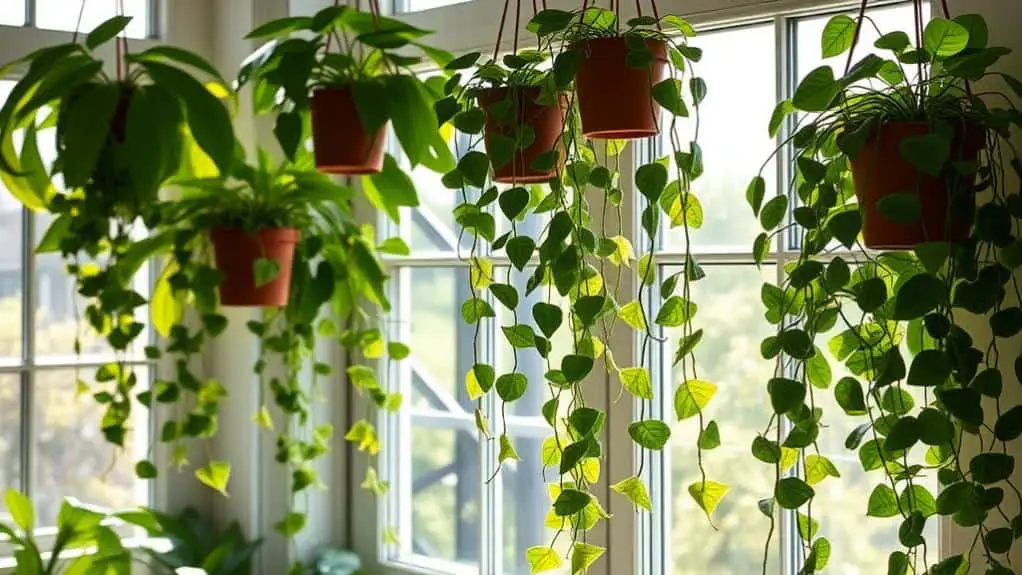
Hoya varieties are amazing plants that are both safe for pets and easy to care for.
They thrive in bright light but can also handle lower light conditions, making them versatile for any spot in your home.
Just remember to let the soil dry out between waterings, and with a little patience, you’ll enjoy their unique leaves and beautiful blooms!
Bright Light Needs
For thriving Hoya varieties, bright light is essential to their ideal growth and flowering.
These plants are safe for your pets, making them perfect non-toxic houseplants for homes with dogs and cats.
Hoya plants thrive when exposed to bright light and water, but they can tolerate lower light conditions, though they’ll grow slower.
Here’s how you can guarantee your Hoya gets the light it needs:
- Place them near a sunny window where they can benefit from indirect sunlight.
- Rotate the plant regularly to guarantee even light exposure for symmetrical growth.
- Adjust watering frequency based on light conditions; more light means more water.
Hoyas are easy to care for and reward you with beautiful clusters of star-shaped flowers!
Resilient Plant Characteristics
One standout feature of Hoya varieties is their incredible resilience. With thick, waxy leaves and woody stems, these houseplants are durable and can thrive in various conditions.
They’re non-toxic to pets, so you can enjoy their beauty without worrying about your furry friends. Hoyas adapt well to different light levels, from bright to low light, making them versatile for any room.
They’re slow-growing, requiring patience, but their stunning foliage is worth the wait. Consistent watering is key; more frequent in brighter light to prevent drought stress.
These resilient plants are perfect for pet owners who want low-maintenance greenery. By choosing Hoyas, you get a beautiful, pet-safe plant that enhances your home’s ambiance.
Watering and Growth Tips
When considering the care of Hoya varieties, understanding their watering and growth needs is essential.
These pet-friendly plants are safe for cats and non-toxic to dogs, making them perfect for your indoor garden.
Here are some growth tips:
- Watering Frequency: Adjust based on light exposure. Less water is needed in low light to avoid overwatering.
- Well-Draining Soil: Use soil designed for succulents or orchids to prevent root rot.
- Monthly Fertilization: During the growing season, provide nutrients to enhance growth and flowering.
Hoyas thrive in bright light but can tolerate low light.
Remember, they grow slowly, so patience is key.
Follow these tips to enjoy a beautiful, pet-safe plant in your home!
Calathea Varieties
Calathea varieties, such as Calathea lancifolia and Calathea orbifolia, bring an aesthetic charm to your home without posing any danger to your pets. These non-toxic plants thrive in low to moderate indirect light, making them perfect for spots that receive filtered sunlight.
They prefer high humidity, so placing them in your bathroom or kitchen is ideal. Keep their soil consistently moist, but avoid overwatering, which can lead to soggy conditions.
Their striking foliage patterns and the way their leaves move in response to light add a dynamic touch to any room. Regular misting is essential, and using distilled water instead of tap water helps prevent exposure to harmful chemicals.
Your pets will be safe, and your home will look stunning!
Spider Plant
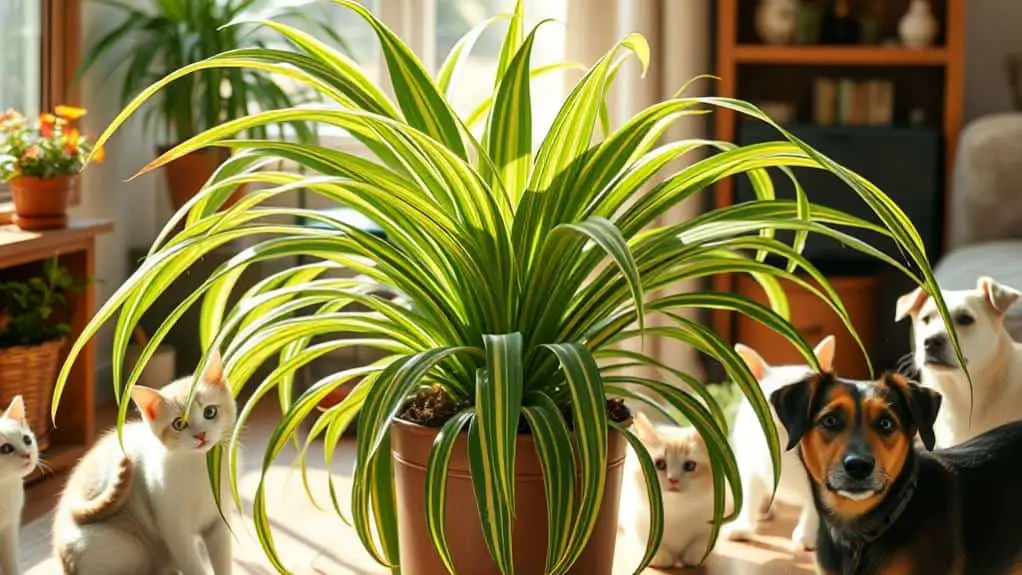
While Calathea varieties add a touch of elegance to any room, the Spider Plant (Chlorophytum comosum) offers a blend of safety and simplicity for pet owners.
These plants are non-toxic to both cats and dogs, making them perfect for pet-friendly homes. Spider Plants are also known for their air-purifying qualities, helping to remove indoor pollutants. They thrive in indirect sunlight and require minimal care, making them ideal for beginners.
Here’s what you need to know:
- Watering: Keep the plant healthy by watering when the top inch of soil dries out.
- Light: They thrive in a variety of light conditions, especially indirect sunlight.
- Propagation: Easily propagate “baby” plants to expand your indoor garden effortlessly.
Spider Plants are a perfect, low-maintenance choice for any home.
Baby Rubber Plant
Let’s talk about the Baby Rubber Plant, which is a fantastic addition to any pet-friendly home.
This plant loves medium to high light but can tolerate low light, although it may grow more slowly.
You only need to water it once a week or when the soil feels dry, making it super easy to care for!
Light Requirements
When it comes to light requirements for the Baby Rubber Plant (Peperomia obtusifolia), you’ll want to aim for medium to high light conditions to guarantee it thrives.
These pet-safe houseplants flourish with bright indirect light, which promotes lush growth and vibrant foliage.
Here are three key tips to keep your Baby Rubber Plant happy:
- Position: Place the plant near a north or east-facing window for ideal light.
- Rotate: Turn the pot occasionally to make certain of even light distribution, helping it grow symmetrically.
- Avoid Direct Sunlight: Too much direct sunlight can scorch the leaves, so keep it shielded to maintain its health.
Watering Frequency
Guaranteeing the right watering frequency for your Baby Rubber Plant (Peperomia obtusifolia) is essential to its health. For ideal plant care, water your Baby Rubber Plant weekly or when the soil is dry to the touch. Be mindful of light conditions, as medium to high light speeds up water needs, while lower light means you might water every 10-14 days. Always check the top inch of the soil for dryness to avoid overwatering, which can lead to root rot. Adjusting watering frequency by season guarantees adequate moisture, especially during the growing season.
Here’s a quick guide:
| Light Level | Watering Frequency | Soil Check |
|---|---|---|
| High | Weekly | Top inch dry |
| Medium | 7-10 days | Top inch dry |
| Low | 10-14 days | Top inch dry |
| Seasonal Adjust | More in spring/summer | Top inch dry |
Growth Conditions
How can you best support the vibrant growth of your Baby Rubber Plant (Peperomia obtusifolia)? Start by ensuring it’s safe and healthy in its indoor environment.
This plant thrives under certain growth conditions:
- Light: While it tolerates low light, medium to high light is ideal for better growth. Place it near a window but avoid direct sunlight.
- Soil and Water: Use well-draining soil to prevent root rot. Water weekly or when the soil feels dry to the touch.
- Humidity and Temperature: Mist occasionally to maintain humidity and keep indoor temperatures between 65-75°F.
With proper care, your Baby Rubber Plant will flourish, remaining safe for your pets and adding a touch of greenery to your home.
Palms
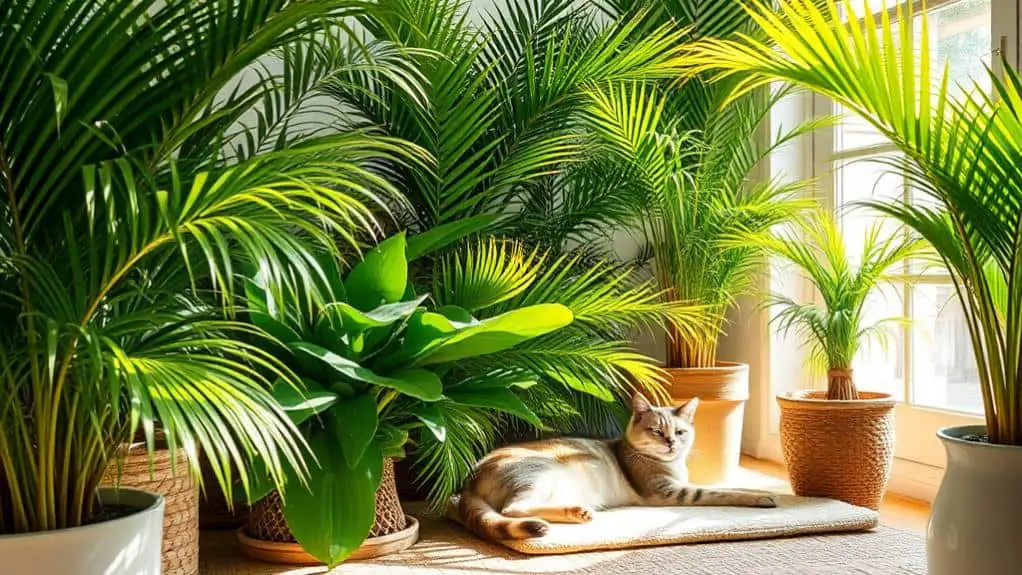
Palms, like the Areca Palm and Parlor Palm, are fantastic choices if you’re looking for pet-safe plants. These palms are non-toxic to pets, making them safe choices for homes with cats and dogs.
They thrive in bright, indirect light and prefer slightly moist soil, not soggy. What’s great is they’re air-purifying, filtering indoor air toxins, which is a bonus for your health.
Palms can adapt to various indoor environments, making them low-maintenance and easy to care for. Their elegant appearance adds a tropical feel to your decor, all while ensuring the safety of your pets.
It’s wonderful to have such beautiful, safe, and practical plants that bring a bit of the tropics indoors!
Ponytail Palm
When it comes to pet-friendly plants, the Ponytail Palm stands out as a top pick. This non-toxic beauty is perfect for households with cats and dogs.
It’s not just safe but also incredibly easy to care for. Here’s why:
- Drought-tolerant: The bulbous base stores water, so it needs minimal watering.
- Light-friendly: Thrives in bright indirect light, but can handle low light too.
- Long-lasting: Grows slowly, offering long-term beauty to your indoor spaces.
These attributes make the Ponytail Palm a versatile and resilient addition to any home.
Whether you’re placing it in a sunny corner or a dim hallway, this plant will flourish without much fuss.
Plus, it’s affordable, typically costing between $25 and $38.
Friendship Plant

Let’s talk about the Friendship Plant, which is perfect for pet owners since it’s safe for both cats and dogs.
This charming plant thrives in bright, indirect light but can also handle lower light conditions, making it easy to find a spot for it in your home.
Just remember to keep its soil moist with regular watering, and you’ll have a happy and healthy plant that’s also super easy to propagate.
Non-Toxic Pet Safety
Among the various plants that can brighten up a home without posing a risk to our furry friends, the Friendship Plant (Pilea involucrata) stands out as a particularly pet-safe option.
This non-toxic plant is safe for both cats and dogs, making it perfect for pet-friendly homes. Let me share why it’s an excellent choice:
- Non-toxic: You won’t have to worry about your pets nibbling on the leaves.
- Pet-friendly: Its textured leaves are attractive and safe around pets.
- Easy to share: You can propagate it easily and share it with fellow pet owners.
Adding the Friendship Plant to your houseplants collection guarantees a safe, beautiful, and pet-friendly environment.
Your home can be both green and worry-free!
Ideal Growing Conditions
To keep your Friendship Plant (Pilea involucrata) thriving, it’s vital to provide the ideal growing conditions. Aim for ideal temperatures between 65 and 75°F (18 to 24°C).
Place the plant in bright, indirect light but know it can handle low light conditions too. Use well-draining soil to prevent waterlogging, and guarantee consistent moisture by watering regularly. The soil should never dry out completely.
Moderate humidity is significant, so regular misting helps keep its leaves vibrant. Remember, this plant loves a bit of pampering!
African Violet
African Violets, or Saintpaulia, are fantastic choices for pet owners looking to add some color to their homes without risking their furry friends’ health.
These lovely plants are non-toxic to both cats or dogs, so you won’t have to worry about your pets nibbling on them.
To keep your African violet thriving, remember three key care tips:
- Bright Indirect Sunlight: Position them in a spot with plenty of indirect sunlight.
- Consistent Moisture: Water them from the bottom to maintain consistent moisture without risking leaf rot.
- Well-Drained Soil: Use a potting mix that’s slightly acidic or neutral and guarantees good drainage.
With proper care, you’ll enjoy vibrant blooms year-round, making your home a colorful and pet-safe haven.
Frequently Asked Questions
What Landscape Plants Are Safe for Dogs?
I know you want dog-friendly shrubs, safe groundcovers, and nontoxic grasses. Try edible landscaping options, pet-safe trees, aromatic herbs, colorful perennials, and drought-resistant plants. They provide beauty and safety for your pets.
What Landscape Plants Are Safe for Dogs?
Ever wondered which native plants are perfect for your garden design? For pet-friendly landscaping, consider dog-friendly herbs and low-maintenance choices like seasonal blooms. These toxic plant alternatives guarantee outdoor safety and a lush, vibrant garden.
What Flowers Are Safe for Cats and Dogs?
You’re asking about safe indoor plants and non-toxic flowers for cats and dogs. Consider African Violets, Christmas Cactus, and Spider Plants. These pet-friendly gardens offer allergy-free blooms, low maintenance, and make decorative pet-safe options.
What Flowers Are Safe for Cats and Dogs?
I often get asked about cat-friendly blooms and dog-safe flowers. Non-toxic houseplants like African Violet and Christmas Cactus are perfect for pet-safe gardens. For fragrant pet plants and colorful pet-friendly flora, Orchids and Gloxinia are ideal.
Conclusion
So, there you have it! With these pet-friendly plants like the Chinese Money Plant, Money Tree, and Spider Plant, you can jazz up your space without turning your home into a danger zone for your furry pals. It’s funny how we stress over decor, but really, it’s just about making smart choices. So go ahead, transform your home into a green oasis that’s safe for everyone, including your curious pets. Happy planting!

